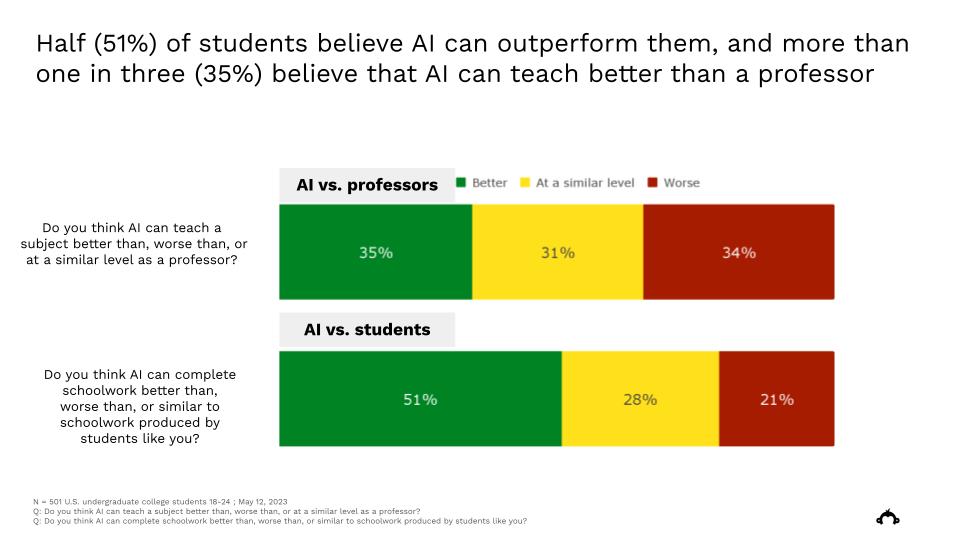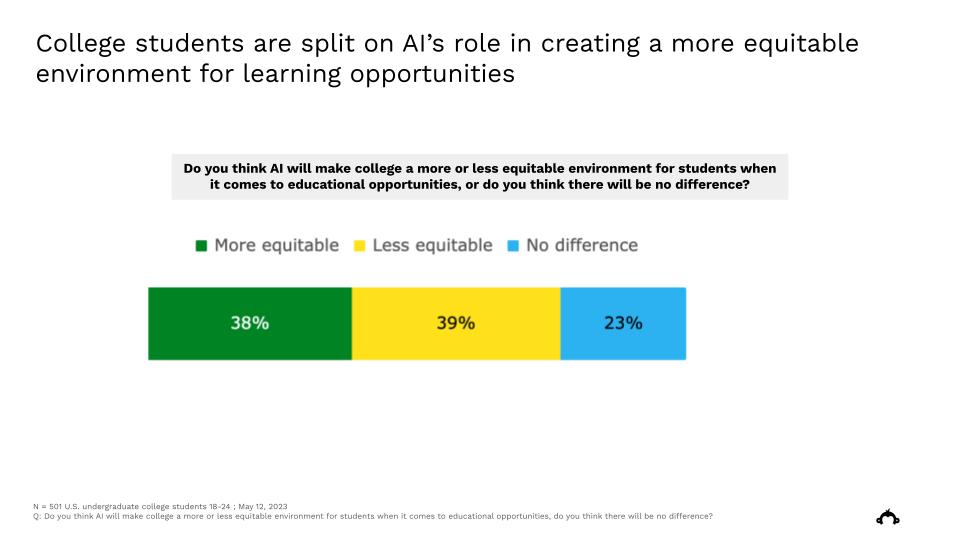Key findings:
- More than 7 in 10 college students have used AI to help with schoolwork
- Half (50%) of undergraduate college students anticipate a decline in job prospects due to AI
- The majority of college students expect AI to play a bigger role in 5 years, but are split on AI’s impact on their education
- STEM undergraduates are less apprehensive than other students about being replaced by AI, but all students are similarly concerned about diminishing job prospects due to AI
- Professors fail to arrive at a consensus on AI usage among students
More than 7 in 10 college students have used AI to help with schoolwork

A clear majority of college students (71%) say they have used AI to help with schoolwork since ChatGPT burst onto the scene six months ago; that includes 17% who have used AI on a daily basis, 21% who have used it weekly, and 33% who have only used AI a few times. Not all are using AI just for schoolwork, with 45% of students saying they used it just for fun, compared with 4 in 10 who used AI to conduct research (42%), complete assignments (42%), summarize reading (40%), or brainstorm ideas (37%).
Half (50%) of undergraduate college students anticipate a decline in job prospects due to AI
Despite the embrace of AI usage for schoolwork, college students are fearful of its impact on the number of available job opportunities after graduation. Half (50%) of undergraduate college students expect AI to reduce the number of opportunities available to them after college, with 40% predicting no impact, and less than one in ten (9%) expecting a net increase in job opportunities due to AI.

Fears over replacement by AI also extend throughout the college experience:
- 51% of college students believe that AI can do a better job at completing schoolwork than they can; 28% believe AI does a similar job, and only 21% believe that AI does a worse job.
- 35% believe that AI can teach better than a professor, compared with 31% who 28% believe AI does a similar job, and only 21% believe that AI does a worse job.
- 61% express concern about AI replacing the skills and knowledge they are acquiring in college.
The majority (71%) of college students support the use of AI for schoolwork, but are split on AI’s impact on their education

Most (78%) college students expect AI to play a bigger role in higher education in 5 years compared to the present, but uncertainty linger on AI’s impact. Despite 71% of college students supporting the use of AI to help with schoolwork, only 35% say the use of AI has a positive impact on college students’ education, slightly edging out the 28% of those who believe AI to have a negative impact.
- Over half (55%) fear that AI will hinder critical thinking skills, compared to 45% of those who believe that AI will empower students in their learning.
- Opinions are also split on AI’s role in bridging the learning gap between students: 38% believe that AI will create a more equitable environment for students when it comes to educational opportunities, on par with 39% who believe that AI will exacerbate inequalities within education. Slightly less than one in four (23%) believe that AI will make no difference.
Professors fail to arrive at a consensus for the use of AI among students, but students are largely content with their school’s approach to AI
The emergence of AI within the classroom has elicited a variety of reactions from professors, with no consensus: 33% have completely banned it, 13% have encouraged the use of AI, 20% tolerated or allowed it, and 33% have ignored its use among students. School policy shows signs of struggle to sufficiently regulate the use of AI in the classroom. Only one in four (23%) say that their school is staying ahead of the curve when it comes to helping students keep up with recent advancements in AI, and a similar number (21%) saying that their school is failing behind. Most (56%), however, think that their school is doing just enough to keep up.
Want more data? Search all SurveyMonkey research by keyword, topic, or media partner.
Read more about our polling methodology here.
Click through all the results in the interactive toplines below:



